How to Convert a Freshwater Tank to Saltwater
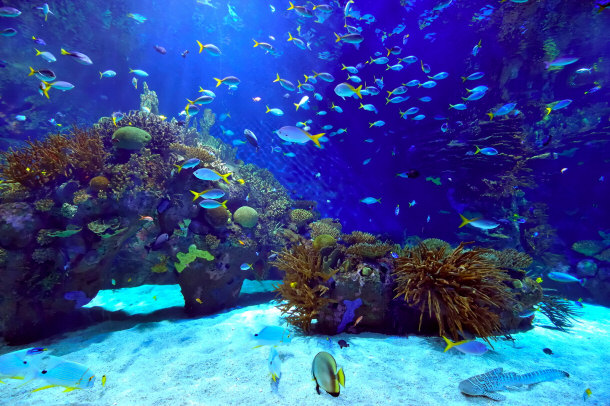
Saltwater Fish Difference
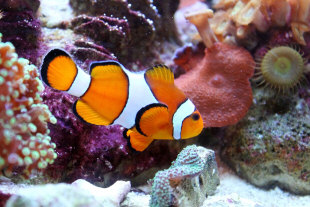 Salt water fish are amazingly beautiful!
If you already have experience caring and maintaining freshwater fish, then
making the transition to a saltwater fish tank can be done so without too much
difficulty. You just have to remember that marine fish drink more water than
their freshwater counterparts. Also, the tank’s pH, salinity and size are
essential to a successful maintenance. Salt water fish are amazingly beautiful!
If you already have experience caring and maintaining freshwater fish, then
making the transition to a saltwater fish tank can be done so without too much
difficulty. You just have to remember that marine fish drink more water than
their freshwater counterparts. Also, the tank’s pH, salinity and size are
essential to a successful maintenance.
That’s because freshwater fish do not normally drink water, but instead,
absorb it through their skin and gills. Saltwater fish, on the other hand, do
consume water. In turn, their gills process the water and remove salt. This
process, also known as osmoregulation, is connected to the water’s balance as it
relates to a fish’s surrounding medium. Because of osmoregulation then,
saltwater fish must drink water in order to make up for the water lost as the
result of the high salt content or salinity in the aquarium’s tank.
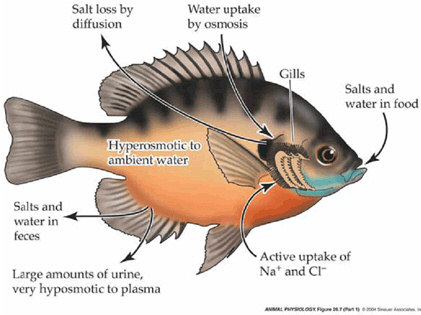
The 3 Different Types of Saltwater Tanks
You have three choices for setting up a saltwater tank:
- Marine fish with live rock - This is the most common type of
saltwater tank, and is my personal favorite.
- Marine fish with dry rock - Dry rocks are a tad cheaper than live
rock. This type of tank uses longer cycles. You can put a few
live rock in there to speed up the cycle time.
- Reef tank - This is the hardest and most complicated of the 3 to
setup.
Reef Tank:
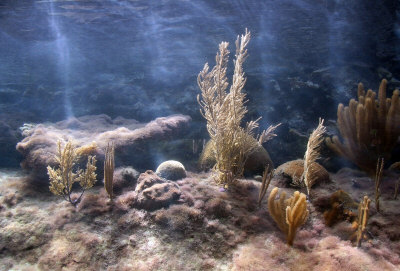
Step By Step Process to Transition to a Saltwater Tank
-
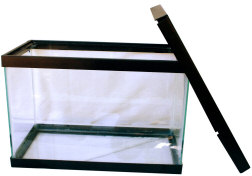 Use
a Big Enough Tank! First make sure your current freshwater tank is big enough, I recommend
between 40-80 gallons for starters. Because marine fish react to
changes in the quality of their water, a bigger tank is better. A 55-gallon tank is a good choice if you are purchasing a
new aquarium. Having a bigger tank will prevent overcrowding, something that you
want to avoid with marine type fish. So, if you want to avoid a Dead Sea type of
scenario from happening, a bigger tank will ensure the survival of your fish.
Therefore, a 55-gallon tank should hold no more than six saltwater fish. Use
a Big Enough Tank! First make sure your current freshwater tank is big enough, I recommend
between 40-80 gallons for starters. Because marine fish react to
changes in the quality of their water, a bigger tank is better. A 55-gallon tank is a good choice if you are purchasing a
new aquarium. Having a bigger tank will prevent overcrowding, something that you
want to avoid with marine type fish. So, if you want to avoid a Dead Sea type of
scenario from happening, a bigger tank will ensure the survival of your fish.
Therefore, a 55-gallon tank should hold no more than six saltwater fish.
- Take all your current freshwater fish, ornaments, and substrates out of your
freshwater tank.
- Take everything else out of the freshwater tank, including all the gravel and then
drain and clean (without soap!) the tank and allow it to dry before putting
anything else into it. This is to ensure all the current freshwater
bacteria die off and will not go into the saltwater. If you didn't do
this, ammonia and nitrite spikes would occur.
- Do not reuse the old freshwater filter media, instead replace them with
new biological and chemical filter media. Filtration in a saltwater
tank is a bit more important than a freshwater tank. You will want to
focus more on biological filtration. A good canister filter works
wonders for saltwater tanks. I would avoid hang-on-tank and under
gravel filters (UGF) as these can lead to more nitrate build up.
- You can use the same old heater you used for your freshwater setup.
-
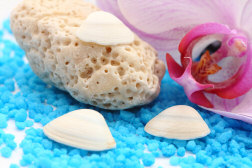 You
will NOT want to put the same decorations in from your freshwater setup,
instead use non plastic ornaments. The exception to this is
live rocks/stones, which you can reuse in your saltwater setup. Do not
use any fake plants or any ornaments using plastic parts. Saltwater
fish have a tendency to actually try to eat the plastic off of these
ornaments (unlike freshwater fish for some reason) which can cause death in
your saltwater fish. Most saltwater tanks use live rock or corals
(either alive or fake and saltwater tank friendly) for it's decorations. You
will NOT want to put the same decorations in from your freshwater setup,
instead use non plastic ornaments. The exception to this is
live rocks/stones, which you can reuse in your saltwater setup. Do not
use any fake plants or any ornaments using plastic parts. Saltwater
fish have a tendency to actually try to eat the plastic off of these
ornaments (unlike freshwater fish for some reason) which can cause death in
your saltwater fish. Most saltwater tanks use live rock or corals
(either alive or fake and saltwater tank friendly) for it's decorations.
- Fill up your new tank with reverse osmosis water. You can
buy one gallon jugs of reverse osmosis water at stores like Wal-Mart.
If you must use tap water (which I don't really recommend), then you must
use a high quality dechlorinator to remove the chlorine from the tap water.
- Add salt to your aquarium. Make sure you read the
instructions on the salt product to make sure you put the right amount in
your tank.
- Let the tank run for a few days to make sure the temperature gets
to around 75F-77F, and make sure everything is running smoothly.
-
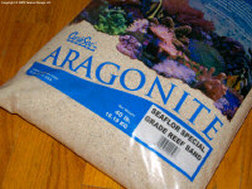 Put
Aragonite substrate (instead of gravel) in the saltwater tank. This
substrate
should be crushed coral or aragonite sand. This helps put the new
saltwater tank in a proper saltwater environment by properly buffering the
calcium, alkalinity and pH of the tank. Put
Aragonite substrate (instead of gravel) in the saltwater tank. This
substrate
should be crushed coral or aragonite sand. This helps put the new
saltwater tank in a proper saltwater environment by properly buffering the
calcium, alkalinity and pH of the tank.
- Put live rock (and/or
live sand) in the saltwater tank. Many experts agree that using a protein skimmer and live rock (and/or
live sand) work great for filtering a saltwater tank. I recommend 1 to
1.5
pound of rock/sand per gallon of water.
Also your live rock must be "cured" before you can add fish to the aquarium.
Curing generally means the initiation of the nitrogen cycle and can take 1-4
weeks (while performing weekly water changes during this process). how
to "cure" live rock is beyond the scope of this article, so if you are
unfamiliar with it I would look up more on how to do this.
- Set up a lighting system that stays on about 10-12 hours per day.
It is common for an algae bloom to occur after a few weeks. In this
case, adding algae eating fish is a good idea to help reduce the algae.
- Test for ammonia and nitrites, when they both read 0 for a few
days in a row then you are safe to start adding your saltwater fish one at a
time.
Tips for the Maintenance and Care of Fish in a Saltwater Tank
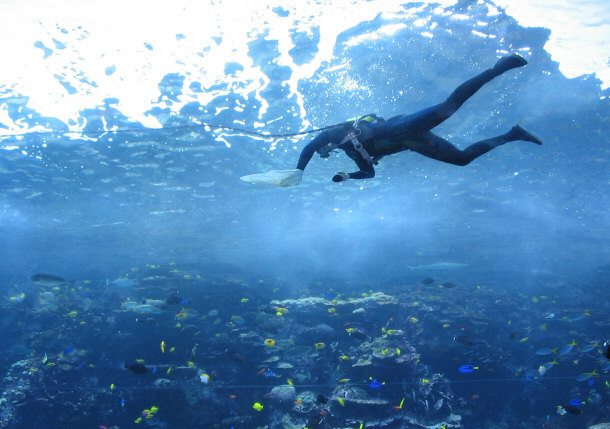 So, if you are graduating to a saltwater tank, you need to keep the above
steps in mind as well as follow the tips below to successfully maintain a
marine environment. So, if you are graduating to a saltwater tank, you need to keep the above
steps in mind as well as follow the tips below to successfully maintain a
marine environment.
• The pH for a saltwater tank should not alter too much as saltwater fish,
again, are more sensitive than freshwater fish in this regard. Therefore, the pH
for a saltwater tank should not be any more than 8.4 or any less than 8.0.
• Temperature too should be routinely regulated. Maintain a temperature that
is right around 75 to 77 degrees Fahrenheit.
• The amount of salt and ions in the water, or the salinity, should remain
level. So, keep the saline level at about 1.022. When water evaporates, the salt
content is increased. So, it’s important to check the salinity of a saltwater
tank consistently throughout the week.
• Air circulation in a saltwater tank is similar to a freshwater tank.
So you can use the same pumps and powerheads that a typical freshwater tank
uses. Some aquarium experts think that saltwater tanks require only a tad
more circulation than freshwater, so keep that in mind.
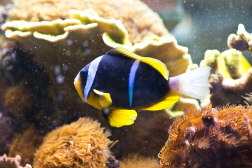 • Also, another important factor in caring for saltwater fish – test the
nitrates in the tank on a weekly basis. If you plan to maintain a reef tank,
then keep the reading at 5 ppm, and no more than 20 ppm for saltwater tanks that
don’t feature invertebrates. • Also, another important factor in caring for saltwater fish – test the
nitrates in the tank on a weekly basis. If you plan to maintain a reef tank,
then keep the reading at 5 ppm, and no more than 20 ppm for saltwater tanks that
don’t feature invertebrates.
• Including supplementation is normally required when your saltwater fish
tank features invertebrates. So, add calcium regularly to keep marine fish
healthy.
Final
Words
Marine fish add color and interest to any décor and you’ll find that
maintenance is not difficult when you develop a routine of care. Hopefully, the
above mentioned suggestions can help you in your transition.
Pets
Top Lists:
18 Richest Animals in the World
15 Exotic Pets You Could Own Today
Top 20 Common Substances That Are Toxic to Cats and Dogs
Informational:
Animal Actors: Pets in the Film, TV, and Print Industry
Caring for a Yorkshire Terrier: Facts You Should Know
Caring for a Pig as a Pet: The Pot-bellied Pig and the Micro Pig
Difference Between a Cat Person And a Dog Person
Should You Microchip your Cat or Dog?
How to Raise and Care for Pygmy Goats
Caring for Unique Pets: The Leopard Gecko
Use Food-Grade Diatomaceous Earth to Kill Fleas Naturally
Dogs:
Top Lists:
Top 15 Dog Breeds For Home Protection
15 Fascinating Facts About The Mastiff
Informational:
How To Teach Your Dog to Hunt for Truffles
Caring for an English Bulldog: Tips and Basic Info
Cranial Cruciate Ligament (CCL) Tears in Dogs: Treating the Injury
How To Keep Your Dog free of Heartworm Disease
Dog With Separation Anxiety?
Cats:
Top Lists:
Top 6 Qualities in an Awesome Cat
Informational:
How to Control Fighting Felines
How to Get Your Cat to Exercise
Fish:
Fish 101 for the Hobbyist: The Fish’s Body and Senses
Buying a Saltwater Aquarium: What You Need to Know
Graduating to a Saltwater Tank
|